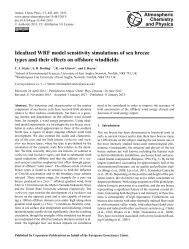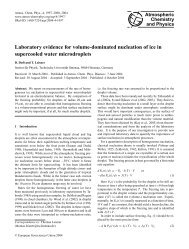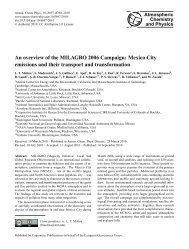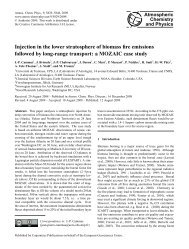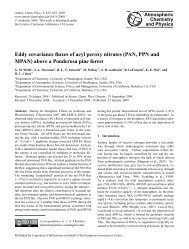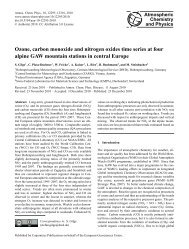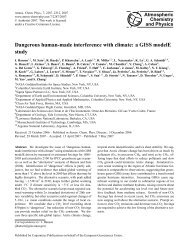A modified band approach for the accurate calculation of online ...
A modified band approach for the accurate calculation of online ...
A modified band approach for the accurate calculation of online ...
Create successful ePaper yourself
Turn your PDF publications into a flip-book with our unique Google optimized e-Paper software.
4154 J. E.Williams et al.: Online photolysis in Chemical Transport Models<br />
Fig. 13. The variation in <strong>the</strong> errors budgets associated with J values <strong>for</strong> (a) OClO, (b) Cl2O2, (c) ClNO3, and (d) BrNO3 with respect to<br />
incident θ <strong>for</strong> a clear-sky scenario using grid B. Comparisons are made against reference B. Results are shown <strong>for</strong> <strong>the</strong> range θ=85–93 ◦ using<br />
<strong>the</strong> PIFM-PS solver. Conditions are identical to those described <strong>for</strong> Fig. 11.<br />
The sensitivity <strong>of</strong> <strong>the</strong> <strong>band</strong> method to <strong>the</strong> values <strong>of</strong> σ and<br />
φ can be elucidated by comparing Fig. 12a with Fig. 5 in<br />
Landgraf and Crutzen (1998). Here, <strong>the</strong> associated errors<br />
calculated <strong>for</strong> JO3 (→O1 D) are approximately double those<br />
shown in <strong>the</strong> original investigation using <strong>the</strong> original <strong>band</strong><br />
settings when no limits are applied to <strong>the</strong> scaling ratio. This<br />
arises from updating <strong>the</strong> method in which φ is determined<br />
(where <strong>the</strong> temperature dependent σ values originate from<br />
Molina and Molina (1986) in both cases). The original quantum<br />
yield was taken from <strong>the</strong> study <strong>of</strong> Talukdar et al. (1998),<br />
whereas <strong>the</strong> one adopted here was based on <strong>the</strong> recommendation<br />
<strong>of</strong> Matsumi et al. (2002), which is a critical syn<strong>the</strong>sis <strong>of</strong><br />
many independent studies. This update leads to substantial<br />
differences especially in <strong>the</strong> contribution made by <strong>the</strong> fourth<br />
<strong>band</strong> to JO3 (→O1 D) and, more importantly, <strong>the</strong> contribution<br />
to <strong>the</strong> total J value made by each wavelength bin (not<br />
shown). From this it maybe concluded that <strong>the</strong> errors associated<br />
with <strong>the</strong> <strong>band</strong> method are critically dependent on <strong>the</strong><br />
input parameters used to determine <strong>the</strong> individual photolysis<br />
rates. There<strong>for</strong>e, it should be noted that any future updates<br />
may affect <strong>the</strong> absolute values <strong>of</strong> <strong>the</strong> associated errors presented<br />
here.<br />
The effect <strong>of</strong> ground albedo on <strong>the</strong> resulting errors was<br />
tested <strong>for</strong> those photolysis rates which are most important<br />
near to <strong>the</strong> ground, as this is where <strong>the</strong> largest perturbation<br />
<strong>of</strong> <strong>the</strong> radiative flux occurs due to enhanced reflection. For<br />
all instances <strong>the</strong> surface was assumed to behave as a Lambertian<br />
Reflector. It was found that <strong>the</strong> per<strong>for</strong>mance <strong>of</strong> <strong>the</strong><br />
<strong>modified</strong> <strong>band</strong> <strong>approach</strong> is fairly robust across <strong>the</strong> range <strong>of</strong><br />
ground albedos from 0.01 through to <strong>the</strong>oretical maximum<br />
<strong>of</strong> 1.0, and, in general, <strong>the</strong> errors remain ra<strong>the</strong>r constant <strong>for</strong><br />
<strong>the</strong> chemical species contained in <strong>the</strong> tropospheric subset.<br />
There<strong>for</strong>e, it can be concluded that <strong>the</strong> <strong>modified</strong> <strong>band</strong> <strong>approach</strong><br />
can be used with confidence over a diverse range <strong>of</strong><br />
reflecting surfaces.<br />
Finally, as a means <strong>of</strong> testing <strong>the</strong> sensitivity <strong>of</strong> <strong>the</strong> <strong>band</strong><br />
method to <strong>the</strong> variation in <strong>the</strong> total overhead O3 column (i.e.<br />
optical depth) duplicate <strong>calculation</strong>s were per<strong>for</strong>med using<br />
Atmos. Chem. Phys., 6, 4137–4161, 2006 www.atmos-chem-phys.net/6/4137/2006/



